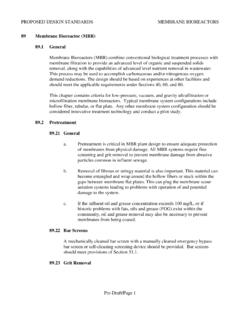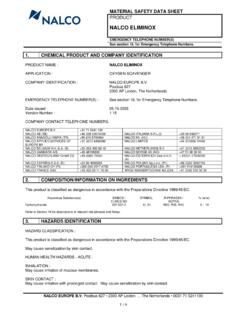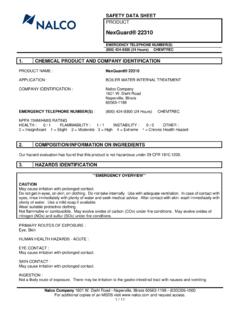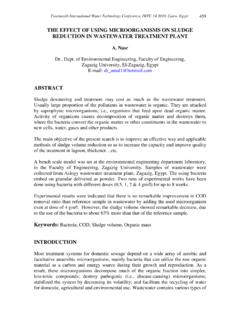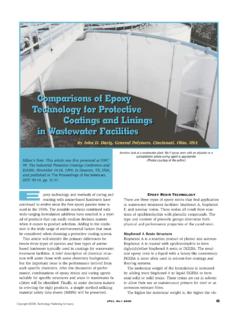Transcription of CHEMICAL ANALYSIS OF MAJOR CONSTITUENTS …
1 CHEMICAL ANALYSIS OF MAJOR CONSTITUENTS AND TRACE CONTAMINANTS OF ROCK SALT Robert V. Titler, Environmental Chemist and Paul Curry, Water Program Specialist Pennsylvania Department of Environmental Protection Bureau of Water Standards and Facility Regulation 1 Executive Summary The main purpose of this study is to analyze various rock salt sources to determine the existing composition of rock salt. The results will then be compared to the CHEMICAL composition of the salt produced from Shale Gas Extraction Wastewater (SGEW) evaporation.
2 Naturally occurring rock salt was formed from the evaporation of inland seas. Its primary CONSTITUENTS are sodium, chloride, calcium, magnesium, potassium, and sulfate. Rock salt generally contains between 90 to 98% sodium chloride. The salt content in SGEW may exceed 200,000 mg/l or approximately 7 times saltier than sea water. In the United States, approximately 77% of the rock salt domestically produced, and imported, is used for highway de-icing. In order to compare the differences or similarities of salt obtained from treated SGEW to conventional rock salt currently being used for de-icing in Pennsylvania, it is necessary to analyze conventional rock salt samples from various sources.
3 At room temperature, rock salt is in the solid state; therefore, an aqueous solution must be prepared for ANALYSIS . The high content of sodium in the rock salt can result in interference issues for metal ANALYSIS using Inductively Coupled Plasma ANALYSIS . In this study, the high sodium and chloride content of the rock salt also caused interferences in the gross alpha and beta analyses as well. Rock salt in its native form should not contain any synthetic organic compounds. The CHEMICAL composition findings in this study are supported by the Assale and Khewra rock salt studies.
4 Calcium was detected in only one of the samples. If the detection limits of calcium were lower, it should have been detected in all of the DEP s rock salt samples. The trace chemicals in rock salt samples could vary depending upon the location and geologic time when the salt deposit was formed. The CHEMICAL composition of rock salt, compared to SGEW, yielded very low concentrations of barium and strontium. Conversely, data reviewed from SGEW analyses indicate that high concentrations of both barium and strontium are usually detected.
5 The low concentrations of the few organic compounds detected in this study could have resulted from contamination during transportation of the rock salt or at its storage location. 2 Introduction The Marcellus Shale Play is estimated to contain more than 500 trillion cubic feet of recoverable natural gas (Engelder, 2008). The process of hydraulic fracturing employed to facilitate extraction of the gas from the deep Marcellus Shale formations uses large quantities typically millions of gallons per well of fresh water.
6 A variety of chemicals and sand are intentionally added to the water to produce a proprietary hydro-fracturing fluid. The added chemicals act to reduce friction, inhibit corrosion or scale formation, and serve as proppants (EPA, 2011). This water also becomes laden with contaminants that are introduced into this mixture below ground as a result of contact with natural formations. A significant portion of this fracking fluid is not retained underground but, due to underground pressure, returns to the surface where it is referred to as flowback water.
7 The drilling/hydrofracturing process also brings large quantities of highly saline water, previously trapped underground, to the surface. The release of these waters, referred to in this document as Shale Gas Extraction Wastewater (SGEW), untreated into surface waters is prohibited. This restriction has created a significant industry in the processing or treatment of SGEW. One product, or byproduct, of the treatment processes is concentrated brine or, in some cases, solid salt. The main purpose of this study is to analyze rock salt from various sources to determine the composition.
8 The results will then be compared to the CHEMICAL composition of the salt produced from SGEW evaporation. This will provide data to determine what, if any, additional pollutants may be introduced into the water column from the fracking practices. Research from the Pennsylvania Department of Environmental Protection (PADEP), Bureau of Oil and Gas Management, shows a high concentration of the metals barium and strontium along with other heavy metals in SGEW. In the crystallization process of SGEW, these metals have to be removed to an acceptable concentration.
9 Rock salt is a sedimentary rock, which is classified as an evaporate. Naturally occurring rock salt is formed from the evaporation of inland seas. The rock salt contains the minerals found in that particular body of water; mostly sodium, chloride, calcium, magnesium, potassium, and sulfate. These are the MAJOR elements found in rock salt. All of these substances are highly soluble in water. Shale is also a sedimentary rock: however, it is classified as a clastic rock layer. Clastic sedimentary rocks are composed predominantly of broken pieces of older weathered and eroded rocks and are classified based on grain size, clastic and cementing material (matrix) composition, and texture.
10 Shale is a fine-grained, clastic sedimentary rock composed of mud that is a mix of flakes of clay minerals and tiny fragments (silt-sized particles) of other minerals, especially quartz and calcite. Many of the minerals that make up shale are insoluble in water. Marcellus Shale is black shale, which is dark, thinly laminated carbonaceous shale, exceptionally rich in organic matter and sulfide and often containing unusual concentrations of certain trace elements such as uranium, vanadium, copper, and nickel.

